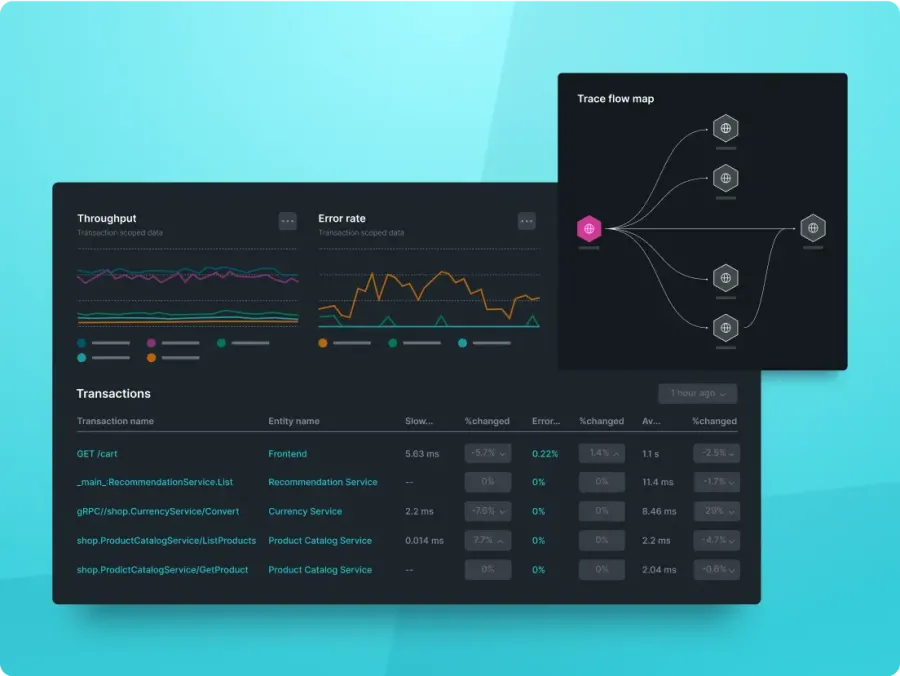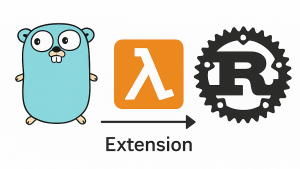RUM and APM are complementary services that provide a comprehensive look at your web applications and infrastructure from the user’s perspective (RUM) and your service layer perspective (APM). They are part of our Intelligent Observability platform.
- RUM monitors and measures activities from your customers’ perspectives. RUM uses real-time data gathered through APIs and embedded JavaScript tags in your pages to measure page load times, errors, and customer engagement.
- APM monitors activities from the server side of your services.
With RUM and APM, data is aggregated into dashboards that offer a clear visual of insights gathered from across your services – from your foundational infrastructure to the user experience.
In this article, we’ll detail how tools differ from and complement each other to give you more actionable insights.
What is real user monitoring (RUM)?
Real user monitoring (RUM) is a feature that is a part of our fully-integrated DEM solution that provides insight into how your users experience your web applications and pages. RUM tracks and measures—in real time—page and object load times, errors, AJAX and HTTP request responses, user engagement, and more. RUM is also called “browser monitoring” because it runs in the end-user's web browser.
RUM can help you better understand your customers’ experiences and what compels them to either keep coming back or exit your site. As a result, you can use relevant data to fine-tune your product and service offerings and convert interest into income.
New Relic Browser Monitoring provides rich user experience data in easy-to-understand, customizable dashboards. Using RUM, your web team can identify where to optimize code and pages to improve user experiences that translate to a stronger bottom line.
How does RUM work?
RUM pulls real-time user activity and page performance data from your user’s browsing journey. To accomplish this, an agent in every page—such as a secure API or embedded JavaScript tag—captures the data stream, sending it to the Browser Monitoring platform. The platform then analyzes the data and transforms it into visual, informational dashboards that offer valuable insights.
RUM can be used to monitor and optimize e-commerce sites, SaaS platforms, mobile apps, and banking and sales transactions. Data is useful to both the business operations and DevOps sides of a business to optimize customer experiences.
What is application performance monitoring (APM)?
Application performance monitoring (APM) is a process of monitoring and managing the performance of software applications throughout their lifecycle, from development to production. This includes measuring key metrics like latency, response times, and error rates to ensure applications meet performance goals and provide a good user experience. Data gathered from continuous, real-time monitoring of your application enables your technical and development teams to track performance, identify issue root causes, and proactively respond to problems before they reach the customer.
With the distributed nature of infrastructures today—on-premises, cloud, containers, etc.—and complexity of applications, all companies should use some form of APM in their services. Customizable, easy-to-interpret dashboards allow your business and technical teams to understand your application’s performance from core to customer, giving the information required to quickly troubleshoot issues before they become problems.

How does APM work?
APM makes it possible to monitor, track, and trace actions from within the application itself, through its supporting technology stack, down to the very foundation of your infrastructure. When you deploy APM, you install agents in each of your technologies or call on functionality embedded in your third-party services.
Data from these agents is consolidated in the APM service, providing detailed analysis about your application—from application performance to code behavior, system performance, and root cause analysis of issues.
RUM vs. APM: key differences
RUM is often considered a part of APM. Although they work together to provide deep insight into your applications, they gather data and provide information from different perspectives.
- APM gathers data from the foundations of your infrastructure to service delivery to the customer using embedded agents and built-in services.
- RUM focuses on the customer’s experience using browser-embedded data gathering.
You need both to get a full analysis of your system, applications, and how the user is engaging with your services. Without both, you only see results from one view or the other. The following table breaks down the general differences between RUM and APM.
RUM | APM | |
Focuses on | User journey | System-side performance |
Gathers data from | User metrics | Server-side metrics |
Coverage | Browser only | Infrastructure to application software |
Analyzes data for | Customer experience | Infrastructure and application performance |
Collects data in/from | Real-time | Real-time Logs |
Metrics | Page and element load times User on-page time Page-load errors Transaction times Single-page application performance (SPA) Golden signals (latency, traffic, errors, saturation) JavaScript errors End-user information (browser, device, OS, geolocation) | Response time Resource usage Throughput Latency Error rate Request rate Application availability (uptime) CPU usage Application performance index (Apdex) score Service level agreement (SLA) score |
Provides information about | User engagement User challenges Application performance in user’s browser | System performance Load testing Performance profiling User feedback A/B testing Synthetic monitoring |
Requires instrumentation | Yes | Yes |
Ideal tool for | UI designers UI developers Product Managers Product/Web Analysts Marketing/sales Customer service/support | DevOps engineers Site reliability engineers (SREs) Software engineers |
Benefits of RUM
RUM lets you see into your customers’ experience in real-time as they engage with your services and properties. This insight is invaluable when it comes to improving your operations. It informs marketing and sales teams about customer motivation, helps designers and developers optimize the user interface, and guides business operations overall.
RUM can help companies:
- Improve the user experience
- Reduce site abandonment and churn
- Improve conversion
- Resolve problems faster
- Drive smarter decision-making
- Tailor content and features
Benefits of APM
APM lets you probe deeply into your overall system performance. This offers vital insights critical for taking a data-backed approach to solving problems, tuning your infrastructure, selecting third-party services, and optimizing your entire technology stack for both cost and performance. APM helps IT teams, DevOps, and customer service operations identify key areas for improvement, allowing them to improve services and power business growth.
APM services can help companies:
- Accelerate application response
- Increase app availability and reliability
- Optimize resource usage
- Optimize costs of infrastructure
- Enhance business performance
How Are APM and RUM used?
APM and RUM are used together to optimize business objectives from infrastructure to code to content. APM is used to monitor all aspects of operations from the technical side, while RUM provides insight into the user’s experience on web and native mobile applications.
They are used across all industries – from e-commerce to SaaS, financial services, and media delivery – for multiple types of devices. Here are just a few examples of where and how APM and RUM help you optimize your business.
- e-Commerce and online retail: Monitor how efficiently your system delivers content to potential buyers with APM, then leverage RUM to help you better understand the customer journey. Optimize your hardware and software, as well as fine-tune product offerings that draw customers to your site and prompt purchases.
- Financial services: When nanoseconds count, response times are critical with financial services. APM lets you see where bottlenecks occur within infrastructure and code, so you can minimize latencies. Using RUM, you can learn which products your customers are most interested in minute by minute and what investment tools they use most.
- Media and content delivery: With streaming content, viewers make watch/don’t watch decisions within the first few minutes of selecting a program. Delays in load times or content that fails to compel can motivate them to click away. APM and RUM can help you see where to improve your infrastructure and applications, and also understand what content holds viewer interest or diverts them elsewhere.
When used in tandem, APM and RUM can help you monitor, discover, and optimize your operations across each of your web properties, dialed into your particular key performance indicators (KPIs).
When to use APM vs. RUM
Both APM and RUM offer end-to-end insight into your online services and those who use them. While they can be used in tandem, both APM and RUM used separately can offer more specific, granular insights into different areas.
Use APM to gain insight into system operations. APM can help you to identify bottlenecks in code and infrastructure, as well as monitor databases for throughput performance. See the minute-by-minute performance, availability, and usage of on-premises and cloud-based servers and containerized resources. Use synthetic monitoring to evaluate scalability and watch user flows without actual users. Query telemetry data for deeper insights, examine logs, and use distributed tracing for root cause analysis.
Use RUM to view your application’s performance in the user’s browser and for a deeper understanding of real-time user behavior. With RUM, you can gain a better understanding of which areas to optimize within a particular user environment, and also discover what content compels your customers to stay or leave.
Knowing which APM and RUM tool to use and when will help your teams quickly tackle issues and optimization tasks, driving better business outcomes.
Can APM and RUM work together?
APM and RUM work together to provide full-stack observability—a clear view of your entire technology stack and how your customers engage with it. In today’s complex IT environments, it can be difficult to pinpoint problems across hardware, software, or infrastructure before they impact your customers and operations.
Together, APM and RUM provide a complete view of resources, code behavior, network traffic, application performance, scalability, user experience, and more. An intelligent observability platform that combines APM and RUM data alongside smart analytics in a fully-integrated solution can help your team maintain system health and resolve issues faster.
Next steps
Whether you run a small business or a large enterprise, RUM and APM provide critical insights that wouldn’t be possible without their unique visibility. With APM, you can better achieve business objectives from a deeper understanding of your application behavior and performance—from your organization’s foundational hardware to delivery to your users. RUM allows you to gain greater insight into your customers’ experiences and understand what will keep them coming back.
Ready to make the leap to an observability platform that integrates both APM and RUM visibility? Learn more about New Relic’s RUM and APM capabilities to help you optimize your services.
The views expressed on this blog are those of the author and do not necessarily reflect the views of New Relic. Any solutions offered by the author are environment-specific and not part of the commercial solutions or support offered by New Relic. Please join us exclusively at the Explorers Hub (discuss.newrelic.com) for questions and support related to this blog post. This blog may contain links to content on third-party sites. By providing such links, New Relic does not adopt, guarantee, approve or endorse the information, views or products available on such sites.



